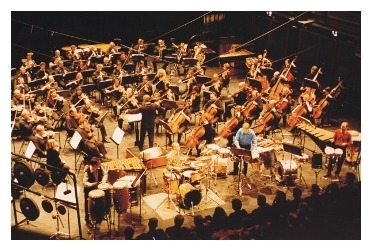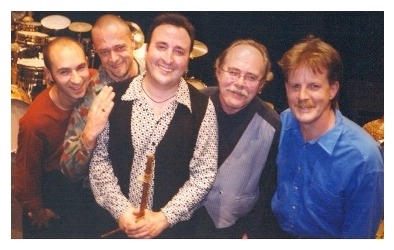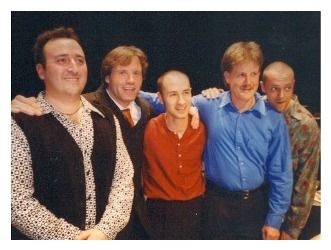MELBOURNE SYMPHONY ORCHESTRA
Conducted by Markus Stenz
MERGE: A MEMOIR OF THE SENSES
Concerto for Percussion and Orchestra composed
by Gerard Brophy
Soloists: Robert Clarke, John Arcaro, Robert
Cossom and Alex Pertout
Metropolis Festival at the
Malthouse Theatre
Saturday 5 June 1999

It is not often that a world premiere by an
Australian composer is performed by the Melbourne Symphony Orchestra, let
alone a piece written specifically to feature the percussion section of
the orchestra, and so I was delighted when I was asked to join Melbourne Symphony Orchestra members
Robert Clarke, John Arcaro and Robert Cossom for this special occasion. The performance took place on Saturday the 5th of June, 1999 with the piece
being an Melbourne Symphony Orchestra commission from composer Gerard Brophy. It was performed
at the Malthouse as part of the Metropolis Festival, the orchestra’s annual
series showcasing 'some of the finest music of our time'. The orchestra
was conducted by Markus Stenz, their chief conductor and artistic director. This article focuses in the performance of this work. This includes
the preparation, percussion instruments used, our rehearsals with and without
the orchestra and also with and without the conductor, the composer’s input,
the concert, the reviews, and a roundtable discussion which I conducted
with my colleagues shortly after the concert.
The Preparation
To start I had meetings with Robert Clarke where
we discussed the score and the possible set ups. This preparation
time also gave everyone a chance to look at their individual parts and
work on areas that they felt required some practice before getting together
as a quartet. As far as the percussion is concerned the piece for
written for the following instruments: drum kit, cymbals, congas, timbales,
timpani, sleigh bells, poinciana pods, shaker, surdo, vibraphone, garbage
bins played with brushes, tam-tam, cowbells, agogo bells, snare drum, Burmese
gongs, bongos, steel drum and bass drum. Later, other instruments
were added including Indian bells, berimbau and shekere.
The Quartet Rehearsals
The quartet rehearsals gave us a chance to basically
workshop our parts. We played the piece pinpointing different areas
which we then dedicated some time to develop further. There were
quite a few areas we had to plan. The introduction for example had
special requirements. The composer had written clear instructions on the
score as to how the piece was to commence. It meant that Robert Cossom
who was playing the drum kit part had to start the piece, then one by one
we had to walk into the auditorium playing our instruments. We had
to basically arrive at our set up in 32 bars. The other area we dedicated
some time to was the 12/8 section at the end of the piece where each of
us had an improvised solo. It was at one of these rehearsals that
I suggested changing the written 32 bar solo marking to an open solo, with
the ending incorporating a cued phrase. The idea was for each of
us to be free enough to take it in any direction, then as an ending the
soloist would play the phrase. This would conclude that particular
solo feature and bring the orchestra back in. It worked well enough
in our rehearsals. The next step was to play it to conductor Markus
Stenz for his approval. The time spent at this initial period was
invaluable, as it made us all feel quite secure about our roles, both
as soloists and as a quartet.
The Piano Rehearsals
The next step organised was a rehearsal with
a pianist playing through the score and with Markus present. This
was a very important rehearsal, as it gave us the opportunity to hear some
of the parts played by the orchestra, relate that to our own parts, and
a run through the piece with Markus. It also gave Markus the opportunity
to think about all the sections. Make some markings regarding possible
cuts to repeats, and also make some decisions including one to cut a section
out altogether. We also worked through our improvised solo sections. As we played the cue phrase he exclaimed “brilliant.“ The idea
for the cue phrase was a success! At his suggestion we also established
an ending to be played outside the auditorium. As we started the
piece by playing our instruments outside the auditorium, why not finish
the piece by playing outside again? Well as the four of us played
the last section on our own it was an easy decision, and it worked.
The Orchestral Rehearsals
The next rehearsals schedule were to include
the entire orchestra. They ran for three days in which we would basically
run through the entire piece and then also work on sections. It was
at these rehearsals that we also got to meet the composer Gerard Brophy. He was friendly and excited about our work on the piece. At
every rehearsal Markus asked him for comments, which he would convey immediately
to the orchestra. In his comments he was also extremely aware of
our needs. On one of these occasions he remarked “the horns should
play a lot softer in this section as Alex is playing the berimbau through
here.” Gerard was incredibly
supportive; it made our parts so much easier to play.
The Performance
This was a special night indeed. The performance
was sold out and there was tremendous atmosphere in the auditorium. The introduction with the three of us walking in while Robert Cossom played
the drum kit worked well and it was a good surprise for the audience. The instruments played while walking were poinciana pods (Robert), Indian
bells (John) and shekere (Alex). As soon as we reached our set ups
we had a couple of bars in which to change instruments which also establish
the strong pulse of the next sections with the full orchestra, featuring
the strings. In these sections we played a variety of instruments
including surdo, timbales, garbage bins, drum kit, cowbells, shakers, caxixis,
tam-tam and snare drum. At times consolidating the rhythm, while
at others featuring in short written solo style phrases. This concluded
with a fairly strong call and response section with snare drums and surdo,
a cross section of marching band and Brazilian escola de samba styles.
The second movement, written in a slow 3/2 pulse
had Robert Clarke on vibraphone as well as playing an interesting roll
on a cymbal which was placed on the timpani head. The technique which
also incorporates pedaling the drum, creates a beautiful cymbal glissando. Robert Cossom played vibraphone and steel drum, while John Arcaro and I
played tuned Burmese gongs and I also improvised on the berimbau. This section also featured some unusual sound effects on tape and some
tender harp lines.
The last movement was written in a fast 12/8 basically
to feature us. We established the pulse, played a solo each, and
after each solo played the cue phrase which brought the orchestra back
in. Our solos on the night where fairly extended. It gave us
all a wonderful opportunity to explore many areas such as time, space,
sound, rhythm, chance, phrasing and dynamics. The
ending as rehearsed, was played outside the auditorium, creating an audible
but fairly distant effect on tom tom, berimbau, agogo bells and caxixis. The performance was a success. The response overwhelming. We
played an encore from the last 12/8 movement to the end repeating our improvised
solos. Then had to come back many times to take a bow.
The Reviews
Johanna Shelleck reviewing for The Herald Sun
wrote: “The final concert in the MSO’s Metropolis Festival was a stunning
conclusion to a sensational series. The challenge in works such as
Gerard Brophy’s Merge: A Memoir Of The Senses, which attempts a broad fusion
of styles and genres, is to create a unique voice rather than watered down
derivatives of the original influences. Some brilliant solo improvisations
by percussionists Robert Clarke, John Arcaro, Robert Cossom and Alex Pertout
ensured that this did not occur. While Joel Crotty reviewing for
The Age stated: “The finale was the world premiere of Gerard Brophy’s Merge: A Memoir Of The Senses. This percussion concerto was very much a
work to highlight the talents of Robert Clarke, John Arcaro, Robert Cossom
and Alex Pertout. It was certainly an audience winner.”

with John Arcaro, Robert Cossom, Gerard Brophy and Robert Clarke
The Roundtable Discussion
A few days after the performance I organised
a get together with my colleagues to discuss the work.
Alex Pertout: Let’s start by discussing
the various set ups employed and the work behind the parts. In your
particular set up Rob how did you develop the actual drum set up required?
Robert Cossom: A lot of it was developed
by looking at the written part, as a lot of it was specifically written
out, for example the tom tom part. I spent a lot of time working
on a simple set up and on a drum kit that generally sounded balanced and
that would work. Getting used to that particular configuration, so
that I knew where everything was. Then developing different things
like solo ideas with that set up, as well as the written part. It
was fun.
Alex Pertout: What about your set
up John, did you add some sounds as well?
John Arcaro: Some of the things
weren’t exactly as written. Say for example sleigh bells, I had some
really interesting Indian bells and I strung them up and they were the
right sharp and short crisp sound rather than having to hit a stick of
sleigh bells to try and play those rhythms. I think Robert Clarke’s
set up was the first to actually take shape and so after I had a look and
a listen to Rob’s set up, it also help me decide what instruments would
complement it or contrast it. There were things like rubbish bins
that we both had on our parts and so Rob had a large one and I had a medium
one, so we really went for things that would complement. I think
we all added bits and pieces.
Alex Pertout: Yes and Gerard was
happy to hear our input.
John Arcaro: Very much so.
Robert Clarke: To me it was going
to be obvious from when we first got the score that it was written in such
a way that it was kind of open ended, and it was good that he left it that
way.
Alex Pertout: Well there is nothing
worse than getting a score which incorporates folkloric instruments, in
which the parts are overwritten. You just loose the value that those
instruments have. Tell me how much did each of you worked on the
parts before we got together?
Robert Cossom: I spent time working
on my part, so that it felt good. One thing is to read it but another
is to actually read it but make it feel good.
John Arcaro: A lot of the time I
spent was more on the sound and the time aspects as well as on the solo
improvised sections. Coming up with ideas that would make sense,
thinking about the rhythms, about developing a nice groove.
Robert Clarke: It is something that
we don’t come across in our daily work in the orchestra. That role
of improvising our solo sections required. It is very unusual
for any player in the orchestra to have this opportunity. I believe
it is the first time improvised solos of that style have been played with
the orchestra.
Robert Cossom: Specially from us.
Robert Clarke: Yes specially from
the percussion section.
Alex Pertout: Well I was thinking
about that afterwards. I mean how many times in your life are you
going to get an opportunity to be featured playing a solo, in my case an
improvised conga solo with an internationally renown orchestra? I
must say that I felt good about the performance on the night as well.
All: Yes!
Alex Pertout: I also felt good for
Gerard. He was also very thoughtful sending us all personal letters
in which he thanked us for our contributions and commitment.
John Arcaro: He obviously really
appreciated the time we put into the piece. Our contributions to
the overall parts, the fact that we cared about it.
Alex Pertout: What about feedback
from the members of the orchestra?
John Arcaro: Oh great feedback from
the orchestra. The general feeling was that they were really excited
about what we were doing. One of the big comments I had was that
it looked like we as a percussion quartet were having a lot of fun.
Robert Cossom: Which was true.
John Arcaro: And that makes the
audience have fun. We were all obviously having a good time, looking
at each other and communicating. Smiling and playing happily.
Robert Clarke: Yes interacting.
Robert Cossom: I had comments from
people in the audience who really enjoyed it because it was a good example
of good music making, the four of us working.
Alex Pertout: That’s exactly right. I must say after all the time we spent rehearsing the parts I felt personally
ready to perform and ready to enjoy myself, and I did!

with Markus Stenz, John Arcaro, Robert Clarke and Robert Cossom
As the performance was recorded, the piece was
broadcast nationally on ABC Classic FM a month after the event. It was certainly
a tremendous project to take part in and an unforgetable experience. My thanks to Markus Stenz for making it so easy for us, to Gerard
Brophy for being so supportive, and to Vince Monea and Chris Wood for the
photos. Special thanks to my colleagues Robert Clarke, Robert Cossom
and John Arcaro.
© Alex Pertout. All rights reserved. No part of this article
may be reproduced without prior written permission from the author. This article was first published in Drumscene magazine.
|

